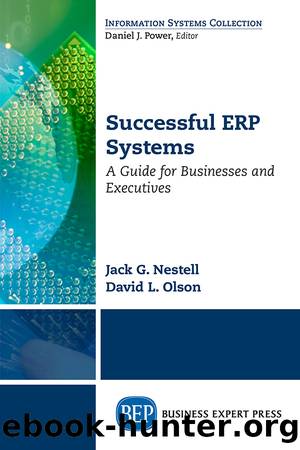Successful ERP Systems: A Guide for Businesses and Executives by Olson David L. & Nestell Jack G

Author:Olson, David L. & Nestell, Jack G. [Olson, David L.]
Language: eng
Format: epub
Publisher: Business Expert Press
Published: 2017-11-20T16:00:00+00:00
CHAPTER 5
ERP System Selection
Installing ERP systems would seem to be a simple matter. After all, the software, while expensive, has been thoroughly tested by many customers. However, ERP implementations are consistently reported by industry sources such as Gartner Group to have failure rates in excess of 60 percent. A business case should be a key part of the process of selecting the form of ERP software for an organization. This chapter will demonstrate the fundamental means of financial analysis and show how other methods can be used to consider other factors describing expected project performance. Cost-benefit analysis seeks to identify accurate measures of benefits and costs in monetary terms and uses the ratio of benefits to costs. Costs and benefits for software systems are inherently difficult to estimate accurately because the many uncertainties, many hidden (unexpected) costs, and potential benefits are difficult to measure precisely.
Total Cost of Ownership
Different types of costs are unique to supply chain software applications:
1.
Obvious cost: The license cost of the software itself is the most understandable.
2.
Cost of system integration: This is probably the single major factor in determining the long-term cost of a system. If a small company buys an inventory control and accounting system, they would want the system be interfaced with their CRM system and also to their shipping system in the warehouse. The company will also need some modifications to the central part order entry system, which interacts with customer and shipping data. Interfaces and the customization are costly and more involved with time.
3.
Cost of implementation: This is the cost of getting the system live in the first place. Implementation costs vary widely based on the application. Components of this cost are data movement services, systems integration, training, consulting, process engineering, and project management.
4.
Expenses of customization: Almost every business software implementation calls for at least some customization. As technology has advanced, the cost of customization has come down; however, this continues to be a major cost with supply chain software.
5.
Platform: Software requires a computer platform. The older the computer platform, the higher the likelihood that a more powerful platform will be required to adequately support a new supply chain software system.
6.
Safeguarding costs: Maintenance to sustain the system is an ongoing annual cost. Companies often charge around 20 percent of the purchase price per year for this cost category.
7.
Training costs: Training of user personnel is critical. A period of about one year is usually required until the trauma of new system implementation passes. This difficult period is easier to cope with if a good, thorough training program is adopted. Managers generally tend to underestimate the magnitude required in such a training program.
Total cost of ownership (TCO) has long been recognized as a significant factor in supply chain software strategies and decisions. Yet, while both end users and vendors tend to talk about lower TCO, and many vendors claim it as a point of differentiation, seldom do they speak in terms of specific metrics.
Because ERP systems involve long timeframes (for benefits, if not for costs as well), considering the net present value of benefits and costs is important.
Download
This site does not store any files on its server. We only index and link to content provided by other sites. Please contact the content providers to delete copyright contents if any and email us, we'll remove relevant links or contents immediately.
Hit Refresh by Satya Nadella(8338)
The Compound Effect by Darren Hardy(7557)
Change Your Questions, Change Your Life by Marilee Adams(6641)
Nudge - Improving Decisions about Health, Wealth, and Happiness by Thaler Sunstein(6633)
The Black Swan by Nassim Nicholas Taleb(6190)
Daring Greatly by Brene Brown(5639)
Deep Work by Cal Newport(5463)
Principles: Life and Work by Ray Dalio(5322)
Rich Dad Poor Dad by Robert T. Kiyosaki(5147)
The Myth of the Strong Leader by Archie Brown(4789)
Man-made Catastrophes and Risk Information Concealment by Dmitry Chernov & Didier Sornette(4735)
Big Magic: Creative Living Beyond Fear by Elizabeth Gilbert(4723)
The Slight Edge by Jeff Olson(4722)
Discipline Equals Freedom by Jocko Willink(4634)
Digital Minimalism by Cal Newport;(4540)
The Motivation Myth by Jeff Haden(4524)
Stone's Rules by Roger Stone(4415)
Management Strategies for the Cloud Revolution: How Cloud Computing Is Transforming Business and Why You Can't Afford to Be Left Behind by Charles Babcock(4130)
The Doodle Revolution by Sunni Brown(4042)
